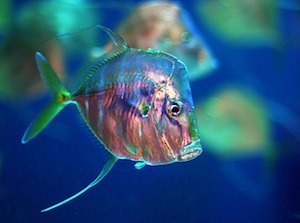Warmer Seas May Increase Mercury in Fish
The marine food chain has another threat as warming waters lead to increased uptake of mercury pollution by some species of fish.
By Alex Kirby, Climate News NetworkThis piece first appeared at Climate News Network.
LONDON — Scientists in the US say they have found evidence suggesting that warmer sea surface temperatures may increase the ability of fish to accumulate mercury.
This could present a risk to the health of some consumers of seafood as the mercury rises up the marine food chain.
The scientists, based at Dartmouth College, New Hampshire, report their research in the journal PLOS ONE (Public Library of Science ONE).
Until now science has known little about how global warming may affect mercury accumulation in marine life, and this is the first study to show the effects using fish in both laboratory and field experiments.
The researchers studied Killifish, found in much of the world – but not in Australia, Antarctica or northern Europe – and living mainly in fresh or brackish water.
They studied the fish under varying temperatures in the lab and in salt marsh pools in Maine. Fish in the marshes ate insects, worms and other natural food sources, while the lab fish were fed mercury-enriched food.
The results showed that fish in warmer water ate more but grew less and had higher methylmercury levels in their tissues, suggesting that increases in their metabolic rate caused the increased mercury uptake.
Mercury released into the air from industrial pollution can accumulate in streams and oceans and is turned into methylmercury in the water.
Risk to health
High levels of methylmercury accumulate in large ocean-going fish such as tuna, swordfish and marlins. Though most people do not eat enough of these to risk mercury poisoning, pregnant women are still advised to restrict their consumption because of possible risk to the unborn child.
In the laboratory experiments, the highest levels of mercury contamination occurred in the fish in the warmest water (27°C). In the salt marsh pools on the coast of Maine the water temperatures ranged from 18 to 22°C. Once again, the warmer pools held fish with greater levels of mercury, even though they were feeding on natural food sources with no added mercury.
The Dartmouth study suggests that climate change may increase the risk to humans. Its finding that pollution levels in the fish may increase with temperature because their metabolism accelerates in warmer water means that as the fish eat more, they absorb more methylmercury from the environment.
Coal-burning power plants produce most atmospheric mercury pollution. When the mercury falls back to Earth it lands either at sea or on land where it can be washed into lakes, streams, and eventually the ocean, contaminating species which find their way into human diets.
Your support matters…Independent journalism is under threat and overshadowed by heavily funded mainstream media.
You can help level the playing field. Become a member.
Your tax-deductible contribution keeps us digging beneath the headlines to give you thought-provoking, investigative reporting and analysis that unearths what's really happening- without compromise.
Give today to support our courageous, independent journalists.









You need to be a supporter to comment.
There are currently no responses to this article.
Be the first to respond.